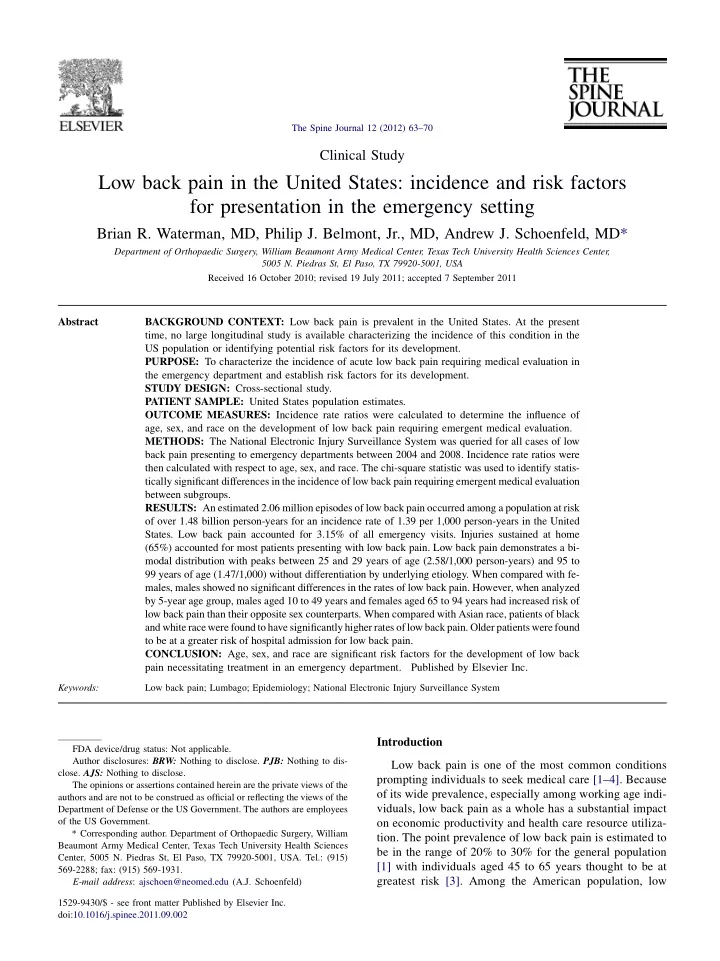

The Spine Journal 12 (2012) 63–70 Clinical Study Low back pain in the United States: incidence and risk factors for presentation in the emergency setting Brian R. Waterman, MD, Philip J. Belmont, Jr., MD, Andrew J. Schoenfeld, MD* Department of Orthopaedic Surgery, William Beaumont Army Medical Center, Texas Tech University Health Sciences Center, 5005 N. Piedras St, El Paso, TX 79920-5001, USA Received 16 October 2010; revised 19 July 2011; accepted 7 September 2011 BACKGROUND CONTEXT: Low back pain is prevalent in the United States. At the present Abstract time, no large longitudinal study is available characterizing the incidence of this condition in the US population or identifying potential risk factors for its development. PURPOSE: To characterize the incidence of acute low back pain requiring medical evaluation in the emergency department and establish risk factors for its development. STUDY DESIGN: Cross-sectional study. PATIENT SAMPLE: United States population estimates. OUTCOME MEASURES: Incidence rate ratios were calculated to determine the influence of age, sex, and race on the development of low back pain requiring emergent medical evaluation. METHODS: The National Electronic Injury Surveillance System was queried for all cases of low back pain presenting to emergency departments between 2004 and 2008. Incidence rate ratios were then calculated with respect to age, sex, and race. The chi-square statistic was used to identify statis- tically significant differences in the incidence of low back pain requiring emergent medical evaluation between subgroups. RESULTS: An estimated 2.06 million episodes of low back pain occurred among a population at risk of over 1.48 billion person-years for an incidence rate of 1.39 per 1,000 person-years in the United States. Low back pain accounted for 3.15% of all emergency visits. Injuries sustained at home (65%) accounted for most patients presenting with low back pain. Low back pain demonstrates a bi- modal distribution with peaks between 25 and 29 years of age (2.58/1,000 person-years) and 95 to 99 years of age (1.47/1,000) without differentiation by underlying etiology. When compared with fe- males, males showed no significant differences in the rates of low back pain. However, when analyzed by 5-year age group, males aged 10 to 49 years and females aged 65 to 94 years had increased risk of low back pain than their opposite sex counterparts. When compared with Asian race, patients of black and white racewere found to have significantly higher rates of low back pain. Older patients were found to be at a greater risk of hospital admission for low back pain. CONCLUSION: Age, sex, and race are significant risk factors for the development of low back pain necessitating treatment in an emergency department. Published by Elsevier Inc. Keywords: Low back pain; Lumbago; Epidemiology; National Electronic Injury Surveillance System Introduction FDA device/drug status: Not applicable. Author disclosures: BRW: Nothing to disclose. PJB: Nothing to dis- Low back pain is one of the most common conditions close. AJS: Nothing to disclose. prompting individuals to seek medical care [1–4]. Because The opinions or assertions contained herein are the private views of the of its wide prevalence, especially among working age indi- authors and are not to be construed as official or reflecting the views of the viduals, low back pain as a whole has a substantial impact Department of Defense or the US Government. The authors are employees of the US Government. on economic productivity and health care resource utiliza- * Corresponding author. Department of Orthopaedic Surgery, William tion. The point prevalence of low back pain is estimated to Beaumont Army Medical Center, Texas Tech University Health Sciences be in the range of 20% to 30% for the general population Center, 5005 N. Piedras St, El Paso, TX 79920-5001, USA. Tel.: (915) [1] with individuals aged 45 to 65 years thought to be at 569-2288; fax: (915) 569-1931. greatest risk [3]. Among the American population, low E-mail address : ajschoen@neomed.edu (A.J. Schoenfeld) 1529-9430/$ - see front matter Published by Elsevier Inc. doi:10.1016/j.spinee.2011.09.002
Recommend
More recommend